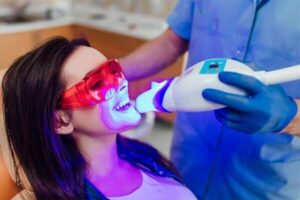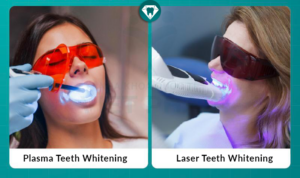Have you ever heard of plasma teeth whitening technology? Similar to laser whitening, this method can help you regain a confident and radiant smile. But what exactly is Plasma whitening, and who is it suitable for? Let’s delve into this method with Joy International Dental Clinic.
1. What is Teeth Whitening with Plasma Light Technology?
Plasma teeth whitening is a modern cosmetic dentistry procedure that utilizes Plasma light technology combined with specialized whitening gels to remove plaque, stains, and discoloration from the surface of your teeth.
Plasma is a type of light with specific wavelengths that exert a powerful effect on the color molecules in teeth, breaking down their bonds and resulting in a brighter, more even-toned smile.
The process typically involves:
- Application of Whitening Gel: A dentist applies a whitening gel containing hydrogen peroxide or carbamide peroxide to the tooth surfaces.
- Plasma Light Activation: A Plasma light is then directed at the teeth. The light activates the molecules in the whitening gel, enhancing their effectiveness in breaking down stains.

2. How effective is plasma teeth whitening in practice?
Whether Plasma light whitening is right for you depends on several individual factors. Here are some points to consider:
- Rapid and Immediate Results: This method offers quick and noticeable results. The whitening process usually takes only 30 to 60 minutes, making it an ideal solution for busy individuals who don’t have time for frequent dental visits.
- Safety When Performed Correctly: Plasma whitening is generally a safe procedure when performed by a qualified dental professional in a reputable clinic with standardized procedures. Choosing a reputable dental clinic is crucial to ensure safety and optimal results.
- Minimized Enamel Damage: Compared to some other whitening methods that use high concentrations of bleaching agents or uncontrolled at-home treatments, Plasma whitening minimizes the risk of damage to tooth enamel. The controlled application and lower concentrations of whitening agents contribute to this safety profile.
- Reduced Sensitivity: Compared to other whitening methods or uncontrolled home remedies, Plasma whitening tends to cause less tooth sensitivity. However, the degree of sensitivity can vary depending on individual factors and pre-existing tooth conditions.
- Significant Aesthetic Improvement: The aesthetic results of Plasma whitening are often remarkable, leading to a brighter, more confident smile. This improvement can significantly boost self-esteem and enhance social interactions.

3. Who is Suitable for Plasma Light Teeth Whitening?
This method is particularly suitable for individuals with teeth stained due to external factors such as frequent consumption of darkly pigmented foods and beverages like coffee, tea, and soda, or tobacco use.
Plasma whitening yields the best results for individuals with healthy teeth and gums. Any existing oral health issues, such as cavities or gum disease, should be addressed before undergoing the whitening procedure to ensure long-term oral health.
Individuals under 16 years of age are generally not suitable for this treatment. Their teeth and oral structures are still developing, and the use of whitening agents could have adverse effects.
4. What is the Standard Medical Procedure for Plasma Light Teeth Whitening?
A standard medical procedure for Plasma light teeth whitening typically involves the following steps:

Step 1: Consultation and Oral Health Examination:
This initial step is crucial for the dentist to thoroughly assess your oral health and determine if you are a suitable candidate for Plasma whitening. This includes a review of your medical history, any prior dental treatments, and a detailed examination of your teeth, gums, and surrounding tissues.
Step 2: Professional Teeth Cleaning:
Thorough cleaning is essential to remove plaque, tartar, and surface stains, allowing the whitening gel to effectively contact the enamel for optimal results. This step typically involves scaling and polishing.
Step 3: Application of Whitening Gel and plasma teeth whitening:
This is the core of the whitening process.
- Gum Protection: The dentist will apply a protective gel or use a dental dam to isolate and protect the gums from the whitening gel, preventing irritation.
- Gel Application: A whitening gel with an appropriate concentration is applied evenly to the tooth surfaces. The concentration is carefully selected based on your individual needs and the severity of staining.
- Plasma Light Exposure: The Plasma light is then directed at the teeth for a specific duration. The light activates the whitening gel, accelerating the breakdown of stain molecules. This process is usually repeated in several short intervals.
Step 4: Post-Treatment Cleaning and Instructions:
After the light exposure, the dentist will remove the gel, rinse your mouth, and assess the results. You will then receive detailed instructions on post-whitening care, including dietary recommendations, oral hygiene practices, and recommended products to maintain your brighter smile.
5. The Difference Between Plasma Light and Laser Teeth Whitening
While both Plasma and laser whitening use light to activate whitening gels, there are key differences:

| Feature | Plasma Light Teeth Whitening | Laser Teeth Whitening |
| Light Type | Broad-spectrum white-blue light (300-750nm), diffused. | Monochromatic light, narrow, highly focused beam (up to 980nm). |
| Mechanism | Activates gel molecules, accelerating the oxidation-reduction process. | Concentrates high energy on the gel, intensifying the oxidation-reduction process. |
| Heat Generation | Less heat generated. | More heat generated. |
| Gel pH | Typically uses neutral or slightly acidic gels (around 6.5). | Typically uses alkaline gels (>= 7). |
| Sensitivity | Generally less sensitivity compared to laser. | May cause more sensitivity, especially in individuals with sensitive teeth. |
| Effectiveness | Effective for mild to moderate external stains. | Effective for both mild and severe stains, including some tetracycline and fluorosis stains. |
| Treatment Time | Typically 30-60 minutes per session. | Potentially slightly faster than Plasma, depending on the specific laser technology used. |
| Cost | Generally less expensive than laser whitening. | Generally more expensive than Plasma whitening. |
| Safety | Safe when performed correctly by a qualified dentist. | Requires skilled and experienced dentists to control the laser energy to avoid soft tissue damage. |
Conclusion
Joy International Dental Clinic has provided you with a comprehensive understanding of Plasma light teeth whitening. This method can help you achieve a more confident and comfortable smile. However, choosing a reputable dental clinic is crucial for the best and safest results. If you have any questions or are considering teeth whitening, we encourage you to consult with a dental professional for personalized advice.






